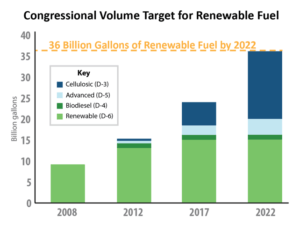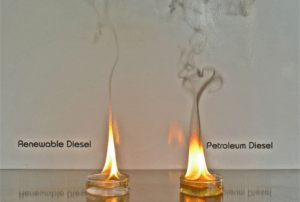Straddling regulation: A refiner’s opportunities and setbacks in the face of climate change

Alon USA faces challenges with increasing climate change regulation in California, but if they can shift to renewables quickly they stand to make a (sustainable) profit.

The oil industry is one of the largest contributors of greenhouse gasses (GHG). It has also been one of the most impacted industries by climate change thus far, mostly due to regulation.
Thanks to increased regulations from the EPA, IRS, and the California Air Resources Board (CARB), California has seen a faster migration toward renewable fuels than the rest of the country. Each of these government agencies provide environmental credits per gallon of renewable fuel, making it more competitive in the marketplace.

Renewable diesel is chemically identical to petroleum diesel, but is made from a renewable source, commonly beef tallow or vegetable oil. Renewable fuels are considered “drop in” and can directly replace petroleum-based fuels.[i]
Alon USA owns refineries in California and the southern US that have been both positively and negatively impacted by climate change regulations.
In 2012, Alon discontinued crude refinery operations in southern California because of the high cost of crude oil relative to yield and asphalt demand.[ii]
Despite those huge setbacks, Alon was able to leverage their success from their crude refineries in the south to fund an investment into their “California renewables project”. They converted part of the refinery in Paramount, CA to produce renewable diesel and jet fuel that turns about 2,500 barrels per day of beef tallow and other feedstocks into renewable fuels. [iii]
Alon’s jet fuel JV, AltAir, is the “world’s first dedicated commercial-scale renewable jet fuel production facility”, producing 35M gallons per year.[iv]
Alon’s 2016 third quarter results were solid with operating margin of $55.81 per barrel and operating income of $6 million.[v] The environmental credits received for every gallon impactful here because they are recorded as part of Alon’s net sales.[vi]
Alon will face several challenges going forward.
- Credit regulations changes could completely upend their economics
- Consumers can’t make the “green choice” at the pump
- Large competitors who have the capital to invest into renewables
- Feedstock is of limited supply and can only scale so far
Consumers:
Even if consumers at the gas station wanted to make the sustainable decision to pay an extra $1 or $2 per gallon for green diesel, they couldn’t.
Most gas stations don’t have separate tanks for renewable and petroleum diesels so Alon must price their diesel with petroleum diesel. If crude oil prices remain lower than feedstock and if the current subsidy regulations expire or shift, Alon could be underwater.
Competitors:
Alon has the first refinery close to scale in California producing renewable fuel, but most of California’s renewable fuel comes from a larger competitor, Neste, based in Helsinki. Neste has contracted with many cities in California as well as UPS.[vii] Foreign Neste receives these same U.S. environmental credits.

Raw materials/supply chain:
Environmental credits are based off of the carbon intensity (CI) of the entire lifecycle of fuel. Alon must find feedstock that has low carbon intensity in order to produce cleaner fuel and claim more credits. Feedstock emits a lot of GHG even prior to the refining process because the animals create methane and the energy required for transportation to the refinery. Furthermore, there is a limited supply of feedstock, so it cannot produce all fuel.
Suggestions for Alon’s future:
- Continue to scale operations to:
- Compete with the larger companies on the civic contracts, etc.
- Afford overhead, etc. in a world without subsidies.
- Diversify fuel sources via investing (or partnering) in research for future, low CI sources such as algae to be ahead of the trend. Algae can grow nearly anywhere there is sunlight, even in waste water. The yield per hectare could even be greater than vegetable oils.[viii] The potential is great, however, today harvesting algae is still much costlier than feedstock.[ix] (794 words)
[i] Alon USA, 2015 Annual Report, p. 4, http://ir.alonusa.com/all-sec-filings/content/0001325955-16-000064/0001325955-16-000064.pdf, accessed November 2016
[ii] Kristen Hays, Nov 7, 2012 “UPDATE 3-Alon to close California refineries for one year”, Reuters, http://www.reuters.com/article/alon-california-refineries-idUSL1E8M7IXF20121107, accessed November 2016.
[iii] Alon USA, “Investor Relations”, http://ir.alonusa.com/, accessed November 2016.
[iv] United Airlines Begins Regular Commercial Flights Using Renewable Jet Fuel Made From Honeywell UOP Technology, March 11, 2016, PR Newswire, http://www.prnewswire.com/news-releases/united-airlines-begins-regular-commercial-flights-using-renewable-jet-fuel-made-from-honeywell-uop-technology-300234559.html, accessed November 2016.
[v] Alon USA, “Alon USA Energy, Inc. Reports Third Quarter 2016 Results”, PR Newswire, http://www.prnewswire.com/news-releases/alon-usa-energy-inc-reports-third-quarter-2016-results-300353074.html, accessed November 2016
[vi] Alon USA, “Investor Relations”, http://ir.alonusa.com/, accessed November 2016.
[vii] Neste, “Solutions for Customers”, https://www.neste.com/en/companies/products/renewable-fuels/neste-renewable-diesel/solutions-customers, accessed November 2016
[viii] Ryan Davis, Daniel Fishman, Edward D. Frank, Mark S. Wigmosta, June 2012, Argonne National Laboratory; National Renewable Energy Laboratory; Pacific Northwest National Laboratory. “Renewable Diesel from Algal Lipids: An Integrated Baseline for Cost, Emissions, and Resource Potential from a Harmonized Model”, http://www.nrel.gov/docs/fy12osti/55431.pdf, accessed November 2016.
[ix] Neste, “Algae oil is a promising raw material for renewable diesel – Neste Oil ensures its supply with conditional purchase agreements”, https://www.neste.com/en/algae-oil-promising-raw-material-renewable-diesel-–-neste-oil-ensures-its-supply-conditional, accessed November 2016.



Interesting article! I had never heard of a renewable diesel before this. As much as I am excited and commend Alon for this innovation, I have a point of inquiry.
It seems to me, as I understand this article, that the problem that Alon addresses is more towards the availability of fuel, i.e. we won’t run out of renewable diesel since it is obtained from beef tallow / vegetable oil, whereas fossil fuels are finite in volume and will deplete over time.
I am curious about the greenhouse warming potential (GWP) of renewable diesel versus petroleum diesel. Since the chemical composition of renewable diesel is similar to petroleum-based diesel, how significantly less is the GWP of renewable diesel than conventional diesel? This needs to be looked at from a life cycle perspective. As agriculture is a significant contributor of greenhouse gas (GHG) emissions (9% of US GHG emissions [1]), any benefits of reduced GWP from the consumption of renewable diesel may be offset by the GHG emitted in the front-end of the life cycle, e.g. in agriculture.
[1] “Sources of Greenhouse Gas Emissions” [https://www.epa.gov/ghgemissions/sources-greenhouse-gas-emissions].
This is a fascinating post! I never knew there was such a thing as renewable diesel. I was particularly struck by the fact that gas stations do not separate petroleum and renewable diesel in tanks – Isn’t there a chemical hazard to doing this? Even if there isn’t a hazard, this process would definitely decrease the purity of gas going into cars, which may spark some disagreement from consumers and automakers. I can imagine a scenario where BMW owners are piling on complaints to BMW headquarters for performance issues of cars that are a result of impure gasoline. I know that when we purchased a new car, my mother always opted for the “super” option because the gasoline was purer and therefore allowed the car to function better.
Moreover, Taylor makes an excellent reference to Alon’s main competitor, Neste. Given that Neste has managed to build such a prominent renewable diesel enterprise amidst the high costs associated with production, I am curious what types of competitive advantages Neste has over Alon. Is it geographical location? Proprietary relationships to important figures who influence the oil industry?
Oh- one more thing! Taylor makes a convincing case about the effects of regulation on refineries to produce more renewable diesel, which is great, but to further her argument I actually found that the customers of refineries are also applying this kind of pressure. Specifically, UPS is planning to increase its use of renewable diesel 15 times over its prior consumption! This results in a whopping 46m gallons! [1]
Hopefully, combined with regulation, these efforts can move the oil industry forward in terms of sustainability.
[1] http://www.hardworkingtrucks.com/ups-nyc-renewable-diesel-facing-availability-issue/#
Great post Taylor! I really enjoyed reading about Alon’s shift from crude oil refining to their “California renewables project.” I’m glad to hear that expertise in crude oil refinery lends itself to expertise in refining renewable fuel (at least in the case of Alon). Also, it’s fascinating that environmental credits in the U.S. are given by a variety of agencies to firms both in and outside of the U.S. (including Neste), and are partly determined by the carbon intensity of the lifecycle of the fuel.
While I completely agree that Alon faces some big challenges, including the threat from large global competitors, I think that Alon may have some big opportunities to effectively market themselves to end-consumers. In the article, you mentioned that gas stations are unable to separate renewable and petroleum diesels into separate tanks. Perhaps, Alon could partner with gas stations to provide stickers, signs, or other marketing materials that the gas at that station is at least partly Alon renewable gas. Additionally, it would make a splashy marketing campaign to partner with an innovative airline company like Virgin America, to market Alon’s jet fuel (AltAir). Increasing end-consumer visibility into the great work Alon is doing could give the company an edge against competitors like Neste.